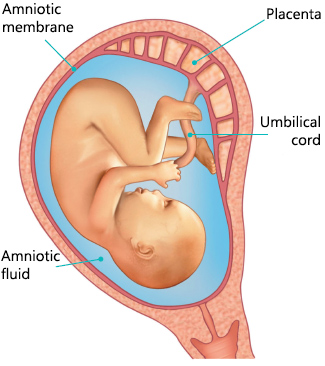Fetus’s environment

Illustration: Maurice Gervais
Amniotic fluid
The amniotic fluid surrounding your baby is essential to his growth and development. Among other things, it:
- Keeps your baby at the right temperature.
- Protects him against shocks from outside the womb.
- Provides space for him to move and develop his muscles and lungs.
The fluid is contained in a kind of pouch that surrounds the baby (amniotic sac or “membrane”). The membrane actually consists of two layers, which is why you will often hear it referred to as “the membranes.”
Just before or during labour, the sac will break, causing the amniotic fluid to leak out. This is what’s known as “breaking the water.”
Placenta and umbilical cord
The placenta starts to grow as soon as the fertilized egg embeds itself in the uterus. It is connected to the baby by the umbilical cord.
At four weeks of pregnancy, blood begins to flow between you and the embryo.
The umbilical cord and placenta carry the oxygen and nutrients your baby needs to grow. They also help get rid of your baby’s waste by returning it to your body, which then eliminates it.
The placenta secretes into the mother’s blood the hormones required to maintain the pregnancy and help the fetus grow. It also acts as a barrier between the mother’s blood and the blood of the fetus.
But the placenta does not filter everything. Certain substances that are harmful to the fetus can get through, including alcohol, certain drugs, and certain medications
Egg: Reproductive cell produced by the ovary. When an egg and a sperm fuse, an embryo may form.
Embryo: Name given during the first full 10 weeks of pregnancy to the human being developing in the mother’s abdomen.
Fetus: Developmental stage of a human being in its mother’s womb, from 10 weeks of pregnancy until birth.
Labour: Process by which the baby passes from the uterus to the outside world, primarily through contractions of the uterus.
Nutrients: Components of food, including vitamins, minerals, proteins, sugars, and fats.


